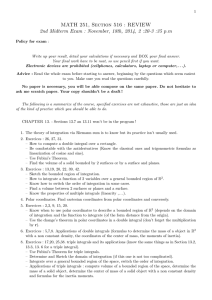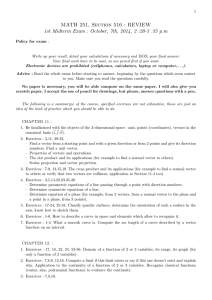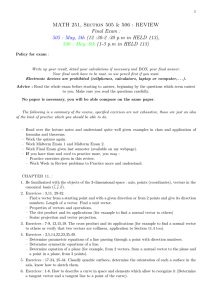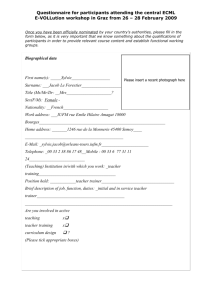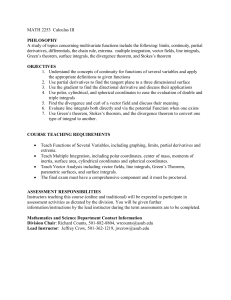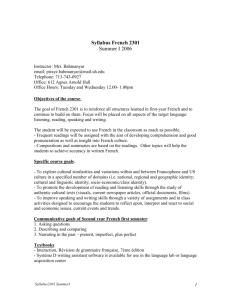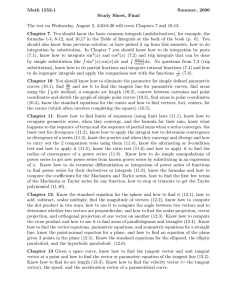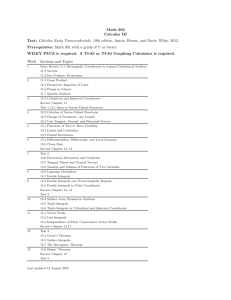MATH 251, Section 516 : REVIEW
advertisement
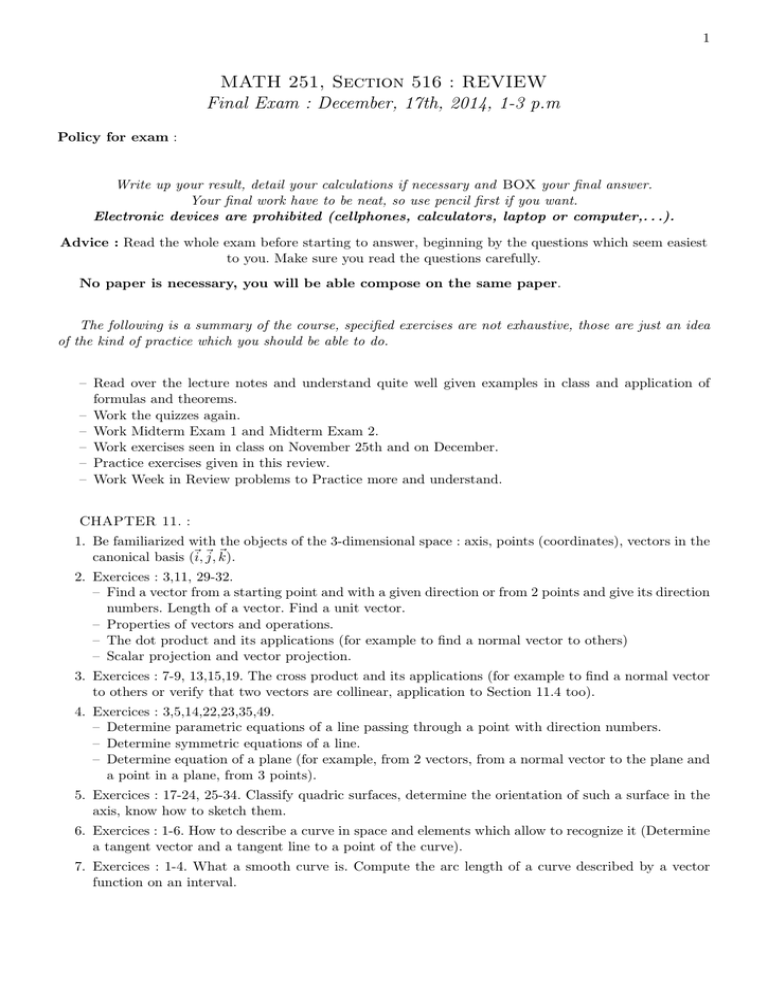
1 MATH 251, Section 516 : REVIEW Final Exam : December, 17th, 2014, 1-3 p.m Policy for exam : Write up your result, detail your calculations if necessary and BOX your final answer. Your final work have to be neat, so use pencil first if you want. Electronic devices are prohibited (cellphones, calculators, laptop or computer,. . .). Advice : Read the whole exam before starting to answer, beginning by the questions which seem easiest to you. Make sure you read the questions carefully. No paper is necessary, you will be able compose on the same paper. The following is a summary of the course, specified exercises are not exhaustive, those are just an idea of the kind of practice which you should be able to do. – Read over the lecture notes and understand quite well given examples in class and application of formulas and theorems. – Work the quizzes again. – Work Midterm Exam 1 and Midterm Exam 2. – Work exercises seen in class on November 25th and on December. – Practice exercises given in this review. – Work Week in Review problems to Practice more and understand. CHAPTER 11. : 1. Be familiarized with the objects of the 3-dimensional space : axis, points (coordinates), vectors in the canonical basis (~i, ~j, ~k). 2. Exercices : 3,11, 29-32. – Find a vector from a starting point and with a given direction or from 2 points and give its direction numbers. Length of a vector. Find a unit vector. – Properties of vectors and operations. – The dot product and its applications (for example to find a normal vector to others) – Scalar projection and vector projection. 3. Exercices : 7-9, 13,15,19. The cross product and its applications (for example to find a normal vector to others or verify that two vectors are collinear, application to Section 11.4 too). 4. Exercices : 3,5,14,22,23,35,49. – Determine parametric equations of a line passing through a point with direction numbers. – Determine symmetric equations of a line. – Determine equation of a plane (for example, from 2 vectors, from a normal vector to the plane and a point in a plane, from 3 points). 5. Exercices : 17-24, 25-34. Classify quadric surfaces, determine the orientation of such a surface in the axis, know how to sketch them. 6. Exercices : 1-6. How to describe a curve in space and elements which allow to recognize it (Determine a tangent vector and a tangent line to a point of the curve). 7. Exercices : 1-4. What a smooth curve is. Compute the arc length of a curve described by a vector function on an interval. 2 CHAPTER 12. : 1. Exercices : 17, 18, 22, 24, 53-56. Domain of a function of 2 or 3 variables, its range, its graph (for only a function of 2 variables). 2. Exercices : 7,8,9, 13,16. Compute a limit if this limit exists or say if this one doesn’t exist and explain why. Application to the continuity of a function of 2 or 3 variables. Recognize classical functions (cosine, sine, polynomial functions) to evaluate the continuity. 3. Exercices : 7,8,10. – Know how to compute the first partial derivatives (or the partial derivatives of the first order) for a function of 2 or 3 variables. – Know how to compute the second partial derivatives (or the partial derivatives of the second order) for a function of 2 or 3 variables. – Application of Clairaut’s Theorem. 4. Exercices : 5,6,17,18, 25-28. – How to determine the tangent plane to the surface of equation z = f (x, y) at a point and a normal vector to it. – Compute the differential of functions of 2 or 3 variables and its applications (to approximation). 5. Exercices : 5,7,13,27,28, 32 1 . Use the chain rule to differentiate the composition of a function of several variables. Implicit differentiation (F (x, y, z) = 0). 6. Exercices : 4,6,13,16,18, 22, 26,37. – Directional derivatives for a differentiable function f of 2 or 3 variables (rate of change of f ). – Gradient (direction of the maximum rate of change) and its geometrical interpretation (to determine an equation of the tangent plane to a surface z = f (x, y) when f is differentiable). 7. Exercices : 1, 3,6, 7, 14. Maximum and Minimum values. Know how to solve a system of 2 equations with 2 unknown variables to determine the critical points and use the method of the Determinant to classify these points (minimum, maximum, saddle points). Know how to determine the maximum and the minimum points on a compact set of R2 . A review section is available at the end of each Chapter, take a look to practice more. CHAPTER 13. : Sections 13.7 an 13.11 won’t be in the program ! 2. Exercices : 26, 27, 31. – How to compute a double integral over a rectangle. Iterated integrals. – Be comfortable with the antiderivatives (Know the classical ones and trigonometric formulas as linearization of cosine and sine). – Use Fubini’s Theorem. – Find the volume of a solid bounded by 2 surfaces or by a surface and planes. 3. Exercices : 13,19, 20, 22, 39, 42. – Sketch the bounded region of integration. – How to integrate a function of 2 variables over a general bounded region of R2 (Region of type I, II). – Know how to switch the order of integration in some cases. 1. Numbers in italic means additional exercises compared to the previous version of this review 3 – Find a volume between 2 surfaces or planes and a surface. – Know the properties of multiple integrals (linearity ,. . .). 4. Polar coordinates. Find cartesian coordinates from polar coordinates and conversely. 5. Exercices : 2,3, 9, 15, 20. – Know when to use polar coordinates to describe a bounded region of R2 (depends on the domain of integration and the function to integrate (of the form distance from the origin). – Use the change’s theorem in polar coordinates in a double integral (don’t forget the multiplication by r). 6. Exercices : 5,7,8. Applications of double integrals (formulas to determine the mass of a object in R2 with a non constant density, the coordinates of the center of mass, the moments of inertia). 8. Exercices : 17,20, 25,38. triple integrals and its applications (know the same things as in Section 13.2, 13.3, 13. 6 for a triple integral). – Use Fubini’s Theorem for triple integrals. – Determine and Sketch the domain of integration (if this one is not too complicated). – Integrate over a general bounded region of the space (Region of type I, II, III), switch the order of integration. – Applications of triple integrals : compute volume of a bounded region of the space, determine the mass of a solid object, determine the center of mass of a solid object with a non constant density and formulas for the inertia moments. 9. Know the formulas to transform cartesian coordinates to cylindrical coordinates and conversely and to obtain the spherical coordinates. 10. Exercices : 1,3,4,5,6,9, 11,15. – Know when use cylindrical or spherical coordinates (to describe the domain and depend on the function to integrate). Use them to describe the appopriate bounded region in the space. – Know very well the change’s theorem in cylindrical coordinates or in spherical coordinates in integrals (don’t forget the multiplication in the integral of r or respectively for spherical coordinates ρ2 sin φ.) – Applications : Know to sketch the integration region from a triple integral under these changes of coordinates, compute a volume under theses changes, . . . A review p. 862 of this chapter in the textbook should be seen. . . CHAPTER 14. : 1. Exercices : 5,7,10,11. What is a vector field ? How to sketch it ? 2. Exercices :4,6, 16, 35, 36. – How to parametrize a curve in R2 or in R3 . Arc length. – Use those parametric equations to compute a line integral with respect to the arc length in R2 or the space R3 . – Compute line integrals with respect to the variable x, or y or z. – Compute the work of a force along a curve ( given by a line integral of a vector field). Be careful in this case, the orientation of the curve counts. 3. Exercices : 1,4, 9, 15,19. – What is a conservative vector field ? What can we say on the work of a conservative force for example ? know the fundamental theorem for line integrals and its interpretation. – What does to be independent of path mean ? – Know the different types of curves and domains. – How to determine when a vector files in the plane is conservative or not ? 4 4. Exercices : 2,3, 16, 21. Know the Green’s theorem and use it. 5. Exercices : 14,17, 18. Definition of the Curl and the divergence and its applications to determine if a vector field in the space is or not conservative and if we can determine a potential function for the curl. Know the second formulation of the Green’s theorem with the operator curl. 6. Exercices : 1,3, 6, 15, 17. Parametric surfaces and their areas. – Find a parametric equation for a surface (ellipsoid, cylinder, paraboiloid. – Thanks to this parametrization, find the tangent plane to the surface at a point. – Find the surface area. 7. Exercices = 3,4,5 ,7, 8, 9, 13, 15,18,19. Z Z f (x, y, z)dS. – Surface integrals of a (scalar) function S Z Z F.dS. – Surface integrals of a vector field S 8. Exercices : 2,5,7, 8,15. Stokes’ Theorem. 9. Exercices : 3,6,11,14. The Divergence Theorem. A review section is also available at the end of Chapter 14, take a look to practice more. Summary ds = integration element with respect to the arc length. dS = |~n|dA used in surface integrals of functions : • If the surface S is give as a graph of a function with 2 variables (Ex : z = g(x, y), (x, y) ∈ D), Then Z Z Z Z f (x, y, z)dS = f (x, yg(x, y))|~n|dA, S D where ~n is the unit normal vector to S. • If the surface S is given by its parametric equation : ~r(u, v), (u, v) ∈ D, Then Z Z Z Z f (x, y, z)dS = f (~r(u, v))|ru × rv (u, v)|dA. S D .dS = ~ndA used in (oriented) surface integrals of vector field : Z Z Z Z F.dS = F.~ndA, S where ~n is a normal vector to S (not necessary unit). D
